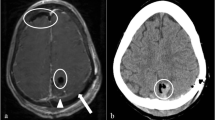Abstract
The objective of this study is to review the occurrence of occult craniocervical junction injury in children. All patients <18 years of age with negative CT of the craniocervical junction and subsequent MRI between July 2003 and June 2008 were included. Age, gender, mechanism of injury, and presence of injuries below C2 were tabulated. Of the forty-five patients with negative CT of the craniocervical junction, 30 had positive MRI findings at the craniocervical junction. Seventeen of the 30 patients fulfilled criteria for significant craniocervical junction injury by MRI. Eleven of 17 patients with significant craniocervical junction injury were less than 8 years old and 13 of 17 were involved in motor vehicle accidents. Six of 12 patients with injury below C2 had significant craniocervical injury. Pediatric craniocervical injuries are often not evident on radiographic or CT imaging but present on MR imaging. Craniocervical injury is most common in younger age groups and is associated with motor vehicle accidents and injuries of the lower cervical spine.





Similar content being viewed by others
References
Reddy S, Backstrom JW, Junewick JJ (2003) Distribution of spinal fractures in children: does age, gender or mechanism of injury play a role? Ped Radiol 33(11):776–781. doi:10.1007/s00247-003-1046-y
Deliganis AV, Baxter AB, Hanson AV et al (2000) Radiologic spectrum of craniocervical distraction injuries. Radiographics 20:S237–S250
Grabb BC, Frye TA, Hedlund GL et al (1999) MRI diagnosis of suspected atlanto-occipital dissociation in childhood. Pediatr Radiol 29:275–281. doi:10.1007/s002470050588
Hosalkar HS, Cain EL, Horn D et al (2005) J Bone Jt Surg 87:2480–2488. doi:10.2106/JBJS.D.01897
Bulas DI, Fitz CR, Johnson DL (1993) Traumatic atlanto-occipital dislocation in children. Radiology 188:155–158
Farley FA, Graziano GP, Hensinger RN (1992) Traumatic atlanto-occipital dislocation in a child. Spine 17:1539–1541. doi:10.1097/00007632-199212000-00022
Kaufman RA, Dunbar JS, Botsford JA, McLaurin RL (1982) Traumatic longitudinal atlanto-occipital distraction injuries in children. AJNR Am J Neuroradiol 3:415–419
Maves CK, Souza A, Prenger EC, Kirks DR (1991) Traumatic atlanto-occipital disruption in children. Pediatr Radiol 21:504–507. doi:10.1007/BF02011724
Lustrin ES, Karakas SP et al (2003) Pediatric cervical spine: normal anatomy, variants, and trauma. Radiographics 23:539–560. doi:10.1148/rg.233025121
Bucholz RW, Burkhead WZ (1979) The pathological anatomy of fatal atlanto-occipital dislocations. J Bone Joint Surg Am 61:248–250
Kaufman RA, Carroll CD, Buncher CR (1987) Atlantooccipital junction: standards for measurement in normal children. AJNR Am J Neuroradiol 8:995–999
Benedetti PF, Fahr LM, Kuhns LR, Hayman LA (2000) MR Imaging findings in spinal ligamentous injury. AJR 174:661–665
Hogan GJ, Mirvis SE, Shanmuganathan K, Scalea TM (2005) Exclusion of unstable cervical spine injury in obtunded patients with blunt trauma: is MR imaging needed when multi-detector row ct findings are normal? Radiology 237:106–113. doi:10.1148/radiol.2371040697
McCall T, Fassett D, Brockmeyer D (2006) Cervical spine trauma in children: a review. Neurosurg Focus 20(2):E5. doi:10.3171/foc.2006.20.2.6
Stassen NA, Williams VA, Gestring ML, Cheng JD, Bankey PE (2006) Magnetic resonance imaging in combination with helical computed tomography provides a safe and efficient method of cervical spine clearance in the obtunded trauma patient. J Trauma 60:171–177. doi:10.1097/01.ta.0000197647.44202.de
Anderson RCE, Scaife ER, Fenton SJ, Kan P, Hansen KW, Brockmeyer DL (2006) Cervical spine clearance after trauma in children. J Neurosurgery 105(5 Suppl Pediatrics):361–364
Padayachee L, Cooper DJ, Irons S, Ackland HM, Thomson K, Rosenfeld J, Kossmann T (2006) Cervical spine clearance in unconscious traumatic brain injury patients: dynamic flexion-extension fluoroscopy versus computed tomography with three-dimensional reconstruction. J Trauma 60:341–345. doi:10.1097/01.ta.0000195716.73126.12
Acknowledgements
We would like to thank Wayne VanderKolk MD and James DeCou from the Spectrum Health Trauma Service for their help in the preparation of this paper.
Author information
Authors and Affiliations
Corresponding author
Rights and permissions
About this article
Cite this article
Junewick, J.J., Meesa, I.R., Luttenton, C.R. et al. Occult injury of the pediatric craniocervical junction. Emerg Radiol 16, 483–488 (2009). https://doi.org/10.1007/s10140-009-0814-x
Received:
Accepted:
Published:
Issue Date:
DOI: https://doi.org/10.1007/s10140-009-0814-x




